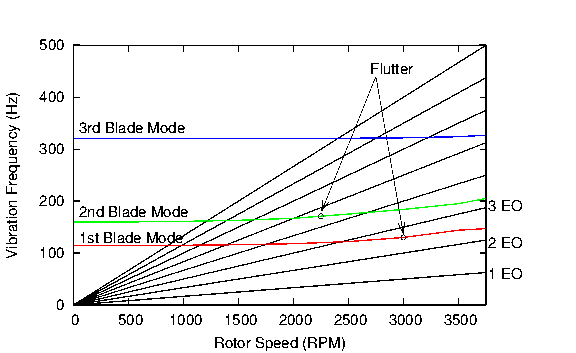Blade flutter is the self-excited vibration of blades due to the
interaction of structural-dynamic and aerodynamic forces.
It is a significant problem for the manufacturers of large-scale
turbomachinery such as gas turbines, steam turbines and aircraft engines.
It can lead to dramatic blade loss in the short-term and high-cycle
fatigue (HCF) in the long-term.
Delays in the development of large-scale turbomachinery due to the
occurrence of flutter can cost manufacturers
millions of dollars per week.
Flutter is a problem for turbomachinery because of the possible phase
differences between the blades when they are vibrating.
If the blades are identical, the aeroelastic modes (coupled structural and aerodynamic system)
are patterns of blade vibration with a constant phase angle
between adjacent blades.
Each aeroelastic mode has a different inter-blade phase angle.
The inter-blade phase angle affects the phase between the local unsteady flow
and local blade motion which in turn affects the
unsteady aerodynamic work done on the blades.
Adverse phase angles can lead to positive work being performed
on the blades which results in flutter.
Flutter can be identified as the cause of blade vibration by examining
the frequency of the vibration.
If the frequency is very close to a blade mode frequency and is
not near an engine order (EO) frequency then the vibration is probably due to flutter.
This can be shown graphically in a Campbell diagram (see below).
Turbomachinery flutter occurs at frequencies very close to a blade
mode frequency because the structural forces dominate and the
aerodynamic forces do not significantly affect the vibration
frequency.

Schematic of Campbell Diagram
In order to evaluate flutter risk, it is necessary
to determine the unsteady flow due to the blade mode shape
for each possible inter-blade phase angle.
The calculated unsteady aerodynamic work is used to calculate the
logarithmic decrement (log-dec)
of the blade motion for each aeroelastic mode.
The log-dec is the rate of decrease in the blade vibration amplitude per cycle.
Negative log-dec values indicate growth in the blade amplitude and a possible flutter problem if there is insufficient mechanical damping.
While other unsteady flow frequencies may exist in
the flow, only the unsteady flow component at the structural frequency
contributes to the work that feeds flutter.
Linear flow analysis can be used to accurately predict the unsteady flow
at the blade mode frequency.
The unsteady flow perturbations are assumed to be small and the unsteady flow
response is assumed to be linear.
This assumption is valid for many flutter cases in turbomachines.
Linear flow analysis is 10 to 100 times faster than conventional
time domain methods and just as accurate for most cases.